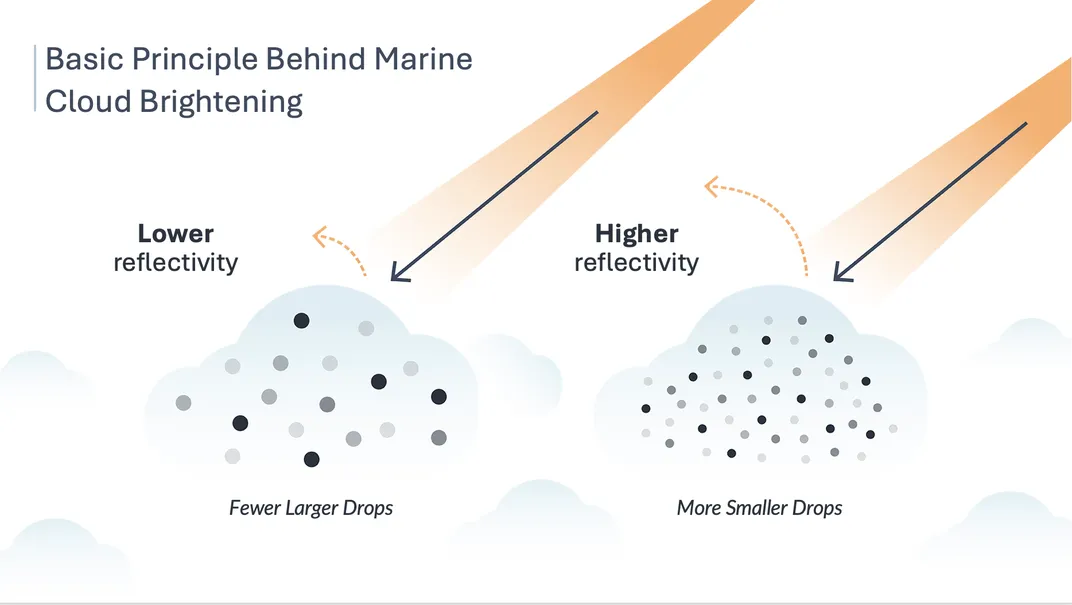Researchers from the University of Washington conducted an initial experiment of cloud brightening technology in Alameda, California, on San Francisco Bay.
Frank Chen via Getty Images
Earlier this month, scientists from the University of Washington gathered in semi-clandestine fashion on the deck of a decommissioned aircraft carrier in San Francisco Bay.
Leading an experiment that was intentionally kept under the radar to minimize public backlash, the team started up a high-powered spraying machine and shot microscopic salt aerosol particles hundreds of feet into the morning air.
The trial, meant to test how well these aerosols could travel outside of the lab, is a basis for a much grander future experiment: using the particles to artificially brighten clouds. The innovation could help clouds reflect more light and keep Earth’s surface a little bit cooler.
“If you increase the number of cloud droplets by increasing the number of sea salt particles, it’s like increasing the number of mirrors to reflect sunlight back to space,” Rob Wood, the lead scientist of the university’s Marine Cloud Brightening Program, tells the San Francisco Chronicle’s Anthony Edwards.
The program’s simulations estimate that brightening 15 percent of the planet’s marine clouds with this method would cool the Earth by about one degree Fahrenheit. But in the real world, uncertainties remain. Getting the correct size and concentration of the particles, for example, is key. Too large or too many, and they’ll contribute to increased precipitation. Too small, on the other hand, and the particles won’t have any noticeable reflective effect.

Changes to the size and number of droplets in clouds can change how much sunlight those clouds reflect back into space.
University of Washington
The test last week took place in Alameda, California, on the USS Hornet, which operates as a Smithsonian Affiliate museum. It was the first cloud brightening experiment ever conducted in North America, and just the second in the world. Four years ago, researchers near Australia’s Great Barrier Reef carried out a similar study in hopes that cloud brightening could protect the region’s corals from bleaching in over-warm waters.
Both experiments fall under the umbrella of geoengineering, a discipline that describes the variety of technological approaches scientists are exploring to help slow or reverse climate change. But the current project—and the field, more broadly—has drawn skepticism for the unknown risks and consequences of tampering with the weather.
“You could well be changing climatic patterns, not just over the sea, but over land as well,” David Santillo, a senior scientist at Greenpeace International who was not involved with the project, tells the New York Times. “This is a scary vision of the future that we should try and avoid at all costs.”
Scientists don’t completely understand some of the possible consequences of launching large amounts of salt aerosols into the atmosphere. For instance, the practice could change ocean circulation patterns or drive unexpected weather—which could, in turn, impact fisheries or farms, writes E&E News’ Corbin Hiar.
Marine Cloud Brightening Project

Though the Biden administration has funded research on marine cloud brightening, per the New York Times, the White House noted to the publication that it did not take part in this particular study: “The U.S. government is not involved in the Solar Radiation Modification (SRM) experiment taking place in Alameda, CA, or anywhere else.”
Over the next several months, the team will analyze the results of this study, examining whether the particles maintained the proper size as they entered the atmosphere. Locally, it remains to be seen when and how future experiments will be carried out.
“Since this experiment was kept under wraps until the test started, we are eager to see how public engagement is being planned and who will be involved,” Shuchi Talati, the executive director of the Alliance for Just Deliberation on Solar Geoengineering who did not participate in the experiment, tells E&E News.
Meanwhile, human-fueled changes to climate and weather patterns continue to break monthly and yearly heat records, affecting communities across the globe. Amid these trends, even the scientists leading the experiment agree that curbing fossil fuel emissions—rather than sending additional particles into the atmosphere—is the best course of action.
“I hope, and I think all my colleagues hope, that we never use these things, that we never have to,” Sarah Doherty, an atmospheric scientist at the University of Washington and the manager of its Marine Cloud Brightening Program, tells the New York Times.
Get the latest stories in your inbox every weekday.
Filed Under:
Climate Change,
Engineering,
Global Warming,
Innovations,
New Research,
San Francisco,
Smithsonian Affiliations,
Sun,
Weather
Copyright for syndicated content belongs to the linked Source link






